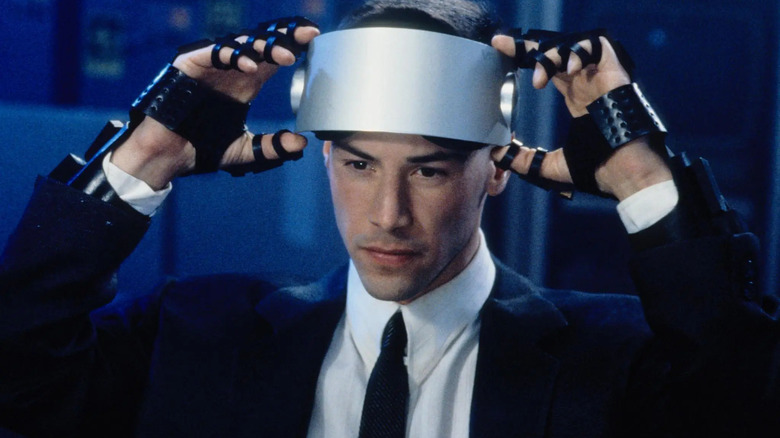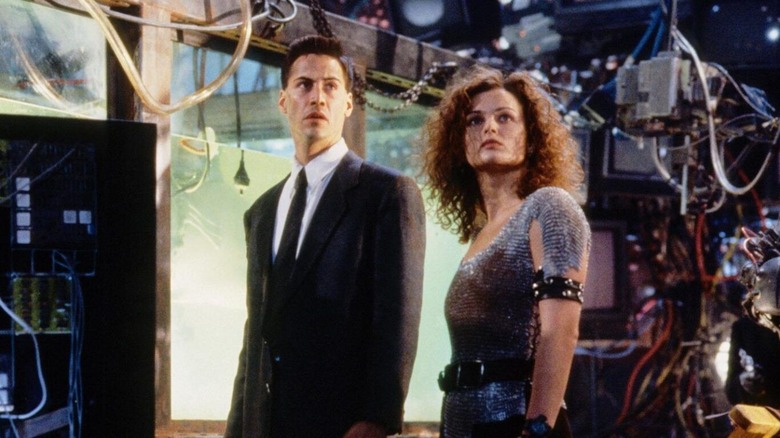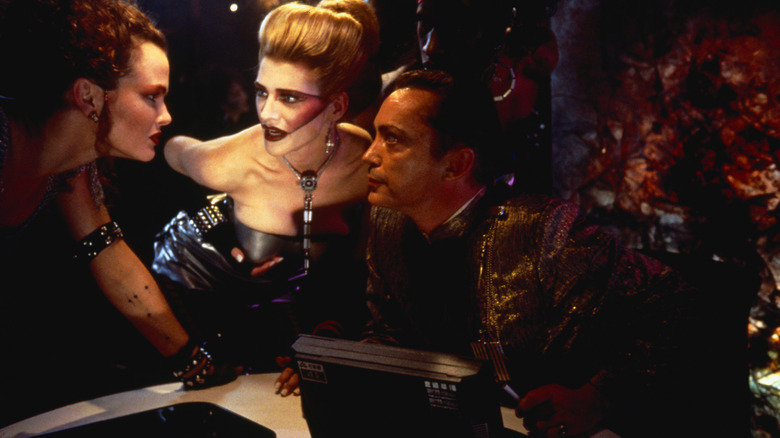Johnny Mnemonic Director Robert Longo Had To Learn Filmmaking On The Fly
In the 1990s, the internet was scary. A lot of new communication technology had opened up to the public, and Hollywood responded by making a slew of paranoid cyber-thrillers, each one positing a near-future world where one's personal information was no longer private, and where wealthy, corrupt international companies paid top-dollar to get said information for their own nefarious purposes. It was a future where the human consciousness had been damaged by prolonged consumption to increasingly truncated information nuggets. I know — crazy, right?
Movies like Brett Leonard's "The Lawnmower Man" envisioned V.R. technology as capable of forcibly evolving the human brain. Iain Softley's "Hackers" (1995) uncovered a neo-punk subculture of computer-savvy teens who would access anything and do anything their prankish minds desired. Irwin Winkler's "The Net" (1995) was the most daring of all, suggesting that future people might spend all their time in online chat rooms and ordering pizza without talking to someone on the phone.
Also in 1995 came Robert Longo's "Johnny Mnemonic," written by William Gibson based on his short story. Set in the future of 2021, "Johnny Mnemonic" starred Keanu Reeves as a futuristic information courier, one of the coolest and most dangerous jobs the future would have to offer. Evidently, information can be hacked incredibly easily in 2021, and keeping it safe requires uploading it into a waiting human brain specially engineered for the process. The owner of said brain will then walk it over to the recipient where a high-tech security code can be flashed into his eyeballs, unlocking it and downloading the information into a waiting secure server.
Longo learns the lingo
There are other strange goings-on in the cyberpunk future of "Johnny Mnemonic" as well. In one scene, Johnny psychically bonds with a cyborg dolphin. Vicious gangsters roam the streets with laser garrote wire that can remove heads in an instant. Ice-T, Takeshi Kitano, Udo Kier, and Henry Rollins all appear in supporting roles. Dina Meyer plays a cybernetically enhanced bodyguard who belongs to a cult-like Messianic cult of technology-averse anarchists calling themselves Lo-Teks. "Johnny Mnemonic" is all very colorful and kooky. It did not get good reviews.
Longo had come from the world of high art, having already been known as a sculptor and photographer. He came to directing via the world of music videos, having made the videos for New Order's "Bizarre Love Triangle," and R.E.M.'s "The One I Love." He moved into scripted entertainment with a 1992 episode of "Tales from the Crypt," and then into feature films with "Johnny Mnemonic." In a 1995 interview with Wired, Longo talked about how he still considered himself a directing neophyte at the time, and how he felt like he had to fake it until he made it. He said:
"There's a Kurt Vonnegut quote I like, something about when you pretend to be someone long enough, one day you'll be that person. I was hoping that'd be true of this experience. 'Cause all of a sudden I'm directing a movie and quietly going, Wait a minute, I really don't know how to do this! Holy s***, where do we put these cameras? It's like waking up out of a dream and realizing you're riding a bike without any handlebars. Like, f***! I gotta keep my balance! I was going totally by instinct. That was all I could do to keep my sanity."
It was all vaguely usettling
More than anything, Longo felt awkward around actors. His cast was full of movie stars, action heroes, cult icons, and pop musicians, and he didn't want to feel like the one to tell them what to do. Unlike music videos, feature directing required more than visuals and vibes. It required character work, something Longo had never done. The director did know how he wanted his actors to look visually, but felt absurd displaying his desires. He said:
"I found the whole experience of making this picture vaguely unsettling. But comical, too. For instance, a lot of times, directing a movie is explaining to the actors what you want them to do, and then actually doing the gestures, which is really weird. You'll say stuff like, 'Walk across the room like this' to seasoned pros, and then you'll show them what you mean with 50 people standing around looking at you like you're a ****ing idiot."
Longo also recalls watching the famed making-of documentary "Hearts of Darkness," about the production of Francis Ford Coppola's "Apocalypse Now." While Longo initially thought the director to be whiny and demanding, once he got behind the camera, he suddenly felt a beleaguered kinship. He said:
"I kept thinking what an incredible a**hole [Coppola] was, with all his petty agonizing and despair. But after about an hour of watching this fat egomaniac, it sunk in: Holy ****, he's just like me! I don't know, I'm just really glad to be back in my studio. [Gibson and I are] like two turtles who stuck their heads out into the real world for a year, but now we're back inside our shells and loving every minute of it."
Needless to say "Johnny Mnemonic" was also Longo's last film.


